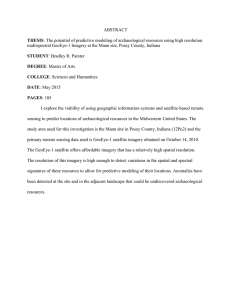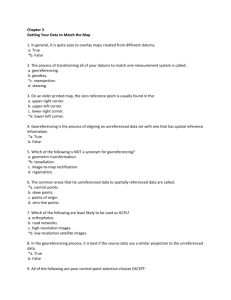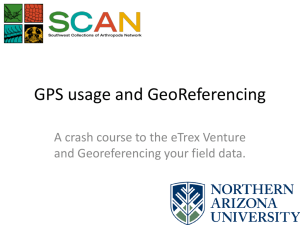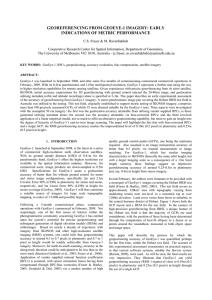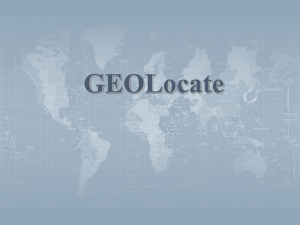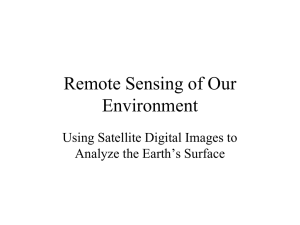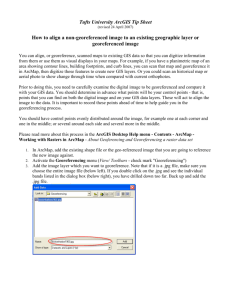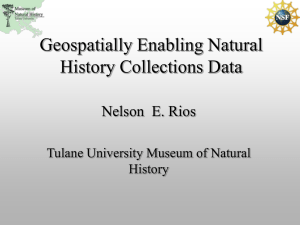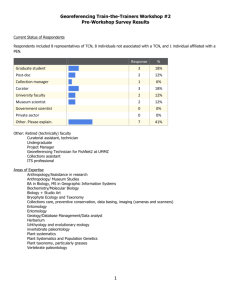GEOREFERENCING ACCURACY OF GEOEYE-1 STEREO IMAGERY:
advertisement
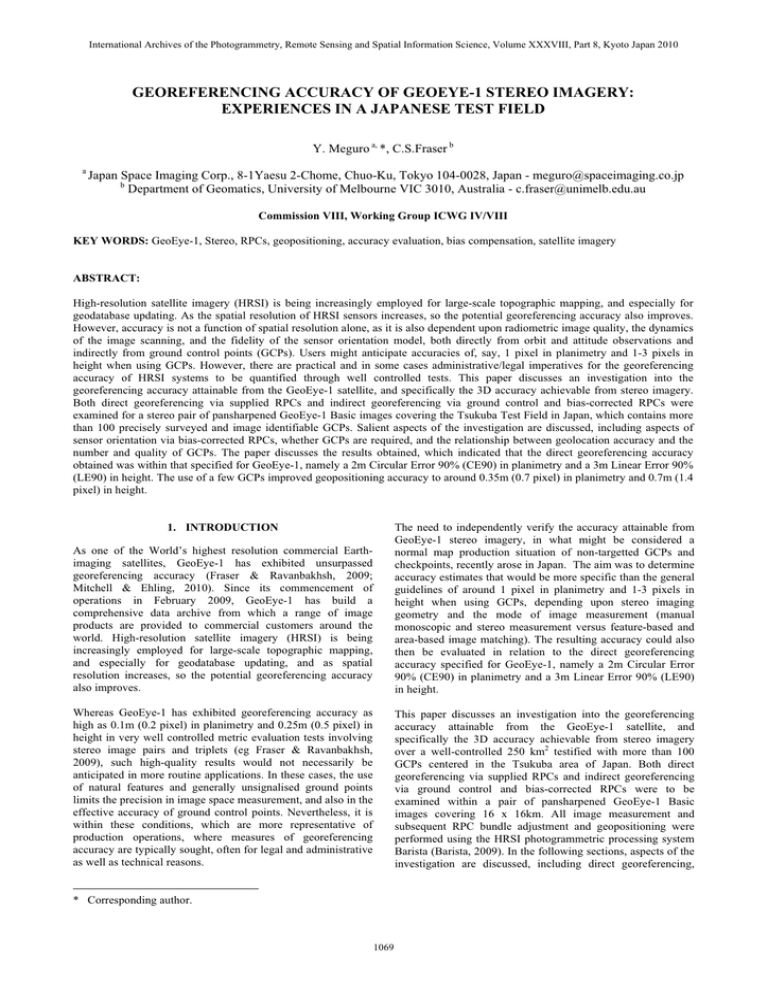
International Archives of the Photogrammetry, Remote Sensing and Spatial Information Science, Volume XXXVIII, Part 8, Kyoto Japan 2010 GEOREFERENCING ACCURACY OF GEOEYE-1 STEREO IMAGERY: EXPERIENCES IN A JAPANESE TEST FIELD Y. Meguro a, *, C.S.Fraser b a Japan Space Imaging Corp., 8-1Yaesu 2-Chome, Chuo-Ku, Tokyo 104-0028, Japan - meguro@spaceimaging.co.jp b Department of Geomatics, University of Melbourne VIC 3010, Australia - c.fraser@unimelb.edu.au Commission VIII, Working Group ICWG IV/VIII KEY WORDS: GeoEye-1, Stereo, RPCs, geopositioning, accuracy evaluation, bias compensation, satellite imagery ABSTRACT: High-resolution satellite imagery (HRSI) is being increasingly employed for large-scale topographic mapping, and especially for geodatabase updating. As the spatial resolution of HRSI sensors increases, so the potential georeferencing accuracy also improves. However, accuracy is not a function of spatial resolution alone, as it is also dependent upon radiometric image quality, the dynamics of the image scanning, and the fidelity of the sensor orientation model, both directly from orbit and attitude observations and indirectly from ground control points (GCPs). Users might anticipate accuracies of, say, 1 pixel in planimetry and 1-3 pixels in height when using GCPs. However, there are practical and in some cases administrative/legal imperatives for the georeferencing accuracy of HRSI systems to be quantified through well controlled tests. This paper discusses an investigation into the georeferencing accuracy attainable from the GeoEye-1 satellite, and specifically the 3D accuracy achievable from stereo imagery. Both direct georeferencing via supplied RPCs and indirect georeferencing via ground control and bias-corrected RPCs were examined for a stereo pair of pansharpened GeoEye-1 Basic images covering the Tsukuba Test Field in Japan, which contains more than 100 precisely surveyed and image identifiable GCPs. Salient aspects of the investigation are discussed, including aspects of sensor orientation via bias-corrected RPCs, whether GCPs are required, and the relationship between geolocation accuracy and the number and quality of GCPs. The paper discusses the results obtained, which indicated that the direct georeferencing accuracy obtained was within that specified for GeoEye-1, namely a 2m Circular Error 90% (CE90) in planimetry and a 3m Linear Error 90% (LE90) in height. The use of a few GCPs improved geopositioning accuracy to around 0.35m (0.7 pixel) in planimetry and 0.7m (1.4 pixel) in height. As one of the World’s highest resolution commercial Earthimaging satellites, GeoEye-1 has exhibited unsurpassed georeferencing accuracy (Fraser & Ravanbakhsh, 2009; Mitchell & Ehling, 2010). Since its commencement of operations in February 2009, GeoEye-1 has build a comprehensive data archive from which a range of image products are provided to commercial customers around the world. High-resolution satellite imagery (HRSI) is being increasingly employed for large-scale topographic mapping, and especially for geodatabase updating, and as spatial resolution increases, so the potential georeferencing accuracy also improves. The need to independently verify the accuracy attainable from GeoEye-1 stereo imagery, in what might be considered a normal map production situation of non-targetted GCPs and checkpoints, recently arose in Japan. The aim was to determine accuracy estimates that would be more specific than the general guidelines of around 1 pixel in planimetry and 1-3 pixels in height when using GCPs, depending upon stereo imaging geometry and the mode of image measurement (manual monoscopic and stereo measurement versus feature-based and area-based image matching). The resulting accuracy could also then be evaluated in relation to the direct georeferencing accuracy specified for GeoEye-1, namely a 2m Circular Error 90% (CE90) in planimetry and a 3m Linear Error 90% (LE90) in height. Whereas GeoEye-1 has exhibited georeferencing accuracy as high as 0.1m (0.2 pixel) in planimetry and 0.25m (0.5 pixel) in height in very well controlled metric evaluation tests involving stereo image pairs and triplets (eg Fraser & Ravanbakhsh, 2009), such high-quality results would not necessarily be anticipated in more routine applications. In these cases, the use of natural features and generally unsignalised ground points limits the precision in image space measurement, and also in the effective accuracy of ground control points. Nevertheless, it is within these conditions, which are more representative of production operations, where measures of georeferencing accuracy are typically sought, often for legal and administrative as well as technical reasons. This paper discusses an investigation into the georeferencing accuracy attainable from the GeoEye-1 satellite, and specifically the 3D accuracy achievable from stereo imagery over a well-controlled 250 km2 testified with more than 100 GCPs centered in the Tsukuba area of Japan. Both direct georeferencing via supplied RPCs and indirect georeferencing via ground control and bias-corrected RPCs were to be examined within a pair of pansharpened GeoEye-1 Basic images covering 16 x 16km. All image measurement and subsequent RPC bundle adjustment and geopositioning were performed using the HRSI photogrammetric processing system Barista (Barista, 2009). In the following sections, aspects of the investigation are discussed, including direct georeferencing, 1. INTRODUCTION * Corresponding author. 1069 International Archives of the Photogrammetry, Remote Sensing and Spatial Information Science, Volume XXXVIII, Part 8, Kyoto Japan 2010 sensor orientation via bias-corrected RPCs, whether GCPs are required, and the relationship between georeferencing accuracy and the number and quality of GCPs. 2. IMAGE DATA SET AND TEST FIELD 2.1 GeoEye-1 Stereopair Figure 2. Sample GCP/Checkpoint pairs. The GeoEye-1 Basic stereo images were collected on November 29, 2009, the scene being 260km2 in area, and the elevation range being from 40m to 450m in the southwest foothills of Mt. Tsukuba. Details of the imaging geometry are provided in Table 1. 1st collected image 2nd collected image Azimuth 340.60 227.70 Elevation 68.40 68.50 Convergence Angle 35.70 B/H Ratio 0.64 3. GROUND POINT DETERMINATION 3.1 RPC Spatial Intersection RPC biases, mainly attributable to small systematic errors in sensor attitude observations, have a direct impact on 3D geopositioning since the errors translate to shifts in object space coordinates. The direct georeferencing accuracy specified for GeoEye-1, namely a 2m Circular Error 90% (CE90) in planimetry and a 3m Linear Error 90% (LE90) in height, implies that these biases will generally be less than 3-4 pixels. Direct georeferencing was performed within Barista using spatial intersection (forward triangulation) with the supplied RPCs and RMS errors (RMSE) were computed at all checkpoints. The resulting RMSE values are shown in Table 2. Table 1. Image geometry of GeoEye-1 stereo pair. 2.2 Ground control and Checkpoints Image-identifiable ground features, most of which were road markings, were used as ground control (GCPs) and/or checkpoints. These were established at 69 locations, there being two distinct points separated by 10-50m at each location. The use of point-pairs allows a better assessment of any localized systematic errors within the georeferencing. The GCPs were surveyed by differential GPS, and not all proved measurable in the imagery, due to local haze conditions, shadowing and saturation in some cases of white road markings. A total of 115 points were deemed suitable for use as GCPs or checkpoints in the experimental testing. The configuration of GCPs and checkpoints is shown in Figure 1, while Figure 2 shows two representative ground point pairs. Number of checkpoints RMSE Easting (m) RMSE Northing (m) RMSE Height (m) 115 0.81 0.48 0.78 Error range -1.6 to -0.1 Error range -1.1 to 0.4 Error range -2.1 to 2.1 Table 2. Result of Forward Intersection Although the resulting checkpoint discrepancy values indicate a direct georeferencing accuracy within the GeoEye-1 specifications, the ranges of error nevertheless indicate the presence of positional biases, principally in the planimetric coordinates. The impact of these biases on the distribution of checkpoint residuals in object space is shown in Figure 3, where the error in planimetry is clearly systematic, while that in height is more random. Figure 1. GCP/Checkpoint configuration, Tsukuba Test Field. Figure 3a. Checkpoint discrepancies in planimetry from direct georeferencing. 1070 International Archives of the Photogrammetry, Remote Sensing and Spatial Information Science, Volume XXXVIII, Part 8, Kyoto Japan 2010 effectively remove the singularity arising from the datum not being ‘fixed’. In order to achieve a ‘free-net’ solution for the Tsukuba GeoEye-1 bundle adjustment, all GCPs were assigned a priori standard errors of 2m (i.e. 4 pixels). The first reason for the bias-compensated bundle adjustment was to achieve an optimal absolute orientation of the stereo model in the sense that it best fit to all ground points and thus minimized the RMSE values of checkpoint discrepancies. The second was that it allowed an identification of outliers that arise through measurement errors in either the GPS or image measurement operations. The use of object point pairs also provided a means to highlight localized systematic errors in the georeferencing. The accuracy obtained in the free-net RPC bundle adjustment is indicated by both the range of coordinate discrepancies obtained as well as their RMSE values, which are provided in Table 3. Figure 3b. Checkpoint discrepancies in height from direct georeferencing. 3.2 RPC Bundle Adjustment with Bias Compensation In order to model and subsequently compensate for the biases inherent in RPCs, a block-adjustment approach introduced, independently by Grodecki and Dial (2003) and Fraser and Hanley (2003) is employed. In this approach, the standard rational function equations that express scaled and normalised line and sample image coordinates (l, s) as ratios of 3rd order polynomials in scaled and normalised object latitude, longitude and height (U,V,W) are supplemented with additional image coordinate correction parameters. These may range from simple shifts in the line/sample coordinates to a correction for affine distortion of the image. Number of checkpoints RMSE Easting (m) RMSE Northing (m) RMSE Height (m) 115 0.28 0.25 0.59 Error range -0.8 to 0.8 Error range -0.7 to 0.9 Error range -1.6 to 1.9 Table 3. RMSE and ranges of coordinate discrepancy values at checkpoints. The attained accuracy is at the ½-pixel level in planimetry and at the 1-pixel level in height. While the resulting georeferencing accuracy is quite acceptable, it is nonetheless below the best level that has been achieved in previous tests with GeoEye-1 (eg Fraser & Ravanbakhsh, 2009; Mitchell & Ehling, 2010). In this instance it is apparent that a combination of natural object point targets and sub-pixel localized systematic error has resulted in less than optimal results. The localized systematic error is indicated by object space coordinate residual vectors at point-pair locations being generally very similar in magnitude and direction, as exemplified in Figure 4. Practical experience with both IKONOS and GeoEye-1 imagery has indicated that of the terms comprising the general additional parameter model, the only two of significance in stereo pair orientation, even for high accuracy applications, are the shift/translation terms. Thus, the bias compensation model utilised for the reported GeoEye-1 imagery has employed only these coordinate translation terms. An additional benefit of confining the image correction model to shift terms alone is that these can then be directly applied to correct the original RPCs, thus providing a very effective means of bias-compensation (Fraser & Hanley, 2003). Alternatives such as utilising the full affine image correction model or modelling the orientation biases in object space lead to the necessity of regenerating the RPCs, which is a less straightforward option than simple correction. (a) planimetry (b) height Figure 4. Checkpoint discrepancies at two point pairs showing systematic error trends. Since the bias estimation and compensation process involves a least-squares adjustment of image coordinate observations and the estimation of exterior orientation, albeit indirectly, it has been termed a ‘bundle adjustment’, or indeed a block adjustment in cases where a number of images are included. A practical means to achieve an optimal accuracy, as expressed by minimum RMSE values for checkpoint discrepancies, is via a ‘free-net’ adjustment approach. Free-net bundle adjustment is generally taken to mean the computation of relative orientation free of any shape constraints imposed by ground control. This can be approximated in RPC bundle adjustment by utilising GCPs with low a priori weights, which are sufficient to Shown in Figure 5 are the checkpoint discrepancies in planimetry and height for the free-net bundle adjustment with bias compensation. The same discrepancy vectors are produced using RPC spatial intersection with the bias-corrected RPCs. Although very localized systematic errors are present at pointpair positions, as indicated in Figure 4, no broader scale systematic error trends are apparent in Figure 5, which highlights the effectiveness of the bias compensation via line/sample shift parameters alone. In this instance the biases were quite small and well within the tolerance implied in the CE90 and LE90 accuracy specifications for GeoEye-1. The 1071 International Archives of the Photogrammetry, Remote Sensing and Spatial Information Science, Volume XXXVIII, Part 8, Kyoto Japan 2010 sample bias was an impressively small 1.74 pixels in image space (0.87m in object space) for both images, whereas the line biases were even smaller at 0.40 and 0.56 pixels. RMSE against Checkpoints (m) Mean Object Point Standard Error (m) Number of GCPs E N Ht E N Ht 1 0.31 0.27 0.78 0.22 0.30 0.63 2 0.32 0.27 0.78 0.21 0.29 0.60 4 0.36 0.26 0.75 0.18 0.26 0.55 6 0.32 0.26 0.76 0.15 0.22 0.45 Table 4: Geopositioning accuracy obtained with different GCP configurations. 4. CONCLUSIONS This investigation within the Tsukuba Test Field has shown that GeoEye-1 can produce ground point determination accuracy of better than 1m (2 pixels) via direct georeferencing with the supplied RPCs, and closer to 0.4m in planimetry and 0.8m in height after the RPCs are corrected for inherent biases. The former of these results is well within specifications for GeoEye1, and the improvement achievable via bias corrected RPCs is at the expense of providing a single GCP, though 3-4 would be recommended. (a) Planimetry 5. REFERENCES Barista, 2010. http://www.baristasoftware.com.au (accessed May, 2010) Fraser, C., Hanley H.B., 2003. Bias compensation in rational functions for IKONOS satellite imagery. Photogrammetric Engineering & Remote Sensing, 69(1): 53-57. Fraser, C.S., Ravanbakhsh, M., 2009. Georeferencing Accuracy of Geoeye-1 Imagery. Photogrammetric Engineering & Remote Sensing, 75(6): 634-638. Grodecki, J., Dial, G., 2003. Block adjustment of highresolution satellite images described by rational functions. PERS, 69(1), 59-68. GeoEye, 2010. GeoEye-1 web site: http://launch.geoeye.com/ (accessed May, 2010) (b) Height Mitchell, G., Ehling, M., 2010. A Geophysical Stereo Satellite Elevation Mapping System. ASPRS 2010 Annual Conference, San Diego, 26-30 April, 12p. (on CDROM) Figure 5. Checkpoint discrepancies in from free-net RPC bundle adjustment with bias compensation. 3.3 Bundle Adjustment with Different GCP Configurations The bias-compensated RPC bundle adjustment was also run with different GCP configurations, the number of GCPs ranging from 1 (114 checkpoints) to 6 (109 checkpoints). All other ground points where employed as checkpoints. The results are shown in Table 4, where it can be seen that basically the same accuracy of 0.7pl in Easting, 0.5 pl in Northing and 1.5 pl in height is achieved, irrespective of the number of GCPs. This is to be anticipated when high-quality GCPs are available, since extra GCPs do not improve the accuracy of orientation, but because any GCP error is directly reflected in the geopositioning (as a shift), the use of multiple GCPs allows an averaging of such errors. So, one GCP is enough, but 3-4 would be recommended for a stereo pair, so that self-checking is possible. 1072
